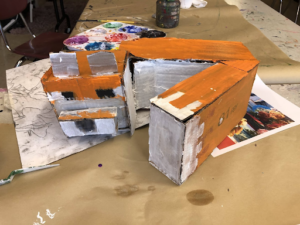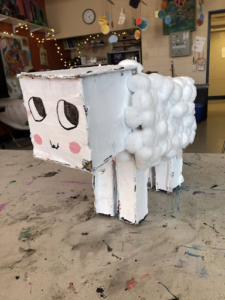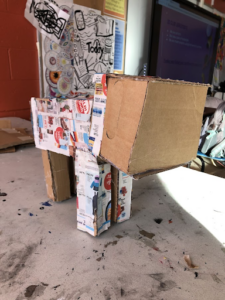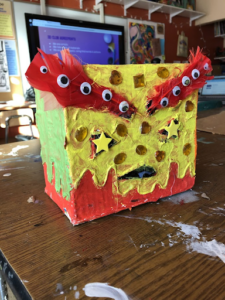Lesson Highlight – Abigail Reeth
There’s a certain energy in the air once 3:30 p.m. rolls around on a school day. After shuffling between classes and following directions for nearly eight hours, middle school students are suddenly transformed. They become reanimated — joking with friends, searching for snacks, reconnecting with their own bodies that were previously folded over desks. This magical hour also marks the start of after school clubs. As a Resident Teaching Artist, I have the opportunity to participate in this end-of-day excitement. Leading about a dozen fifth through eighth graders, I feel both pressure and privilege in offering my students’ art activities that differ from their daily classroom experiences in the form of a 3D art club.

Over the past months, I have found that Pinterest is my best friend in lesson planning for after school art. While the platform can be a rabbit hole of endless recommended projects, it also provides me with inspiration to borrow, alter, and combine to create activities that hopefully pique the interest of my individual students. These art projects often feel like the at-home science experiments I used to conduct in my parents’ kitchen — it’s a gamble whether the results will actually look anything like the initial inspiration. However, the best art projects are sometimes those that veer off the guided path. I want my students to think and create for themselves rather than simply following a set of directions toward a uniform product. 3D art club is the perfect setting for this artistic experimentation. Here, there are no grades or rubrics, just time and materials to try and fail, to readjust and discover.
When I found a post on Pinterest showing monster masks made of recycled materials and papier mâché, I decided to use this as the basis for an open-ended project titled Cardboard Creatures. This lesson reminded me of myself as a middle schooler, enjoying hours creating objects and toys from various recyclables. While I don’t consider myself a 3D artist now, I find this same joy in collecting collage materials, layering textured paint, and creating handmade paper. I hoped the Cardboard Creatures lesson would spark similar enthusiasm and artistic curiosity in my students.


To start the project, I asked my students to brainstorm and draw designs for creatures (real or mythical) which they would construct with cardboard. We discussed the easiest ways to cut and assemble three-dimensional forms from cardboard by first making a cube as the base and building off that structure. The students spent several sessions constructing their creatures with cardboard, tape, and hot glue—with supervision, of course. Notably, I found that when invested in their projects, students used materials responsibly and readily helped one another. Once the cardboard was assembled, the young artists covered their creations with strips of newspaper dipped in a mixture of glue and water to make a papier mâché layer. Finally, they painted their projects and decorated them with additional materials, such as feathers and sequins.
As I had hoped, each cardboard creature turned out completely unique. There was a fluffy sheep, a Minecraft fox, and an angry monster who appeared to have mustard dripping down his face. Some students finished their projects quickly while others took their time perfecting details and bringing their visions to life. Naturally, we experienced numerous mishaps throughout the process. Pieces fell apart. Paint dried out. Cardboard cutouts vanished among disorganized stacks of supplies. Still, I was impressed by the students’ problem-solving and dedication throughout the process. Many students thrived when given the time and space to follow their ideas and experiment with materials. After finishing the project, they were excited to bring their creatures home to show friends and family. The students created in ways I couldn’t have anticipated or manufactured through detailed lesson plans or step-by-step instructions. Maybe the project’s success was due to the contagious after school energy. Probably, it was thanks to the students’ imaginative creativity combined with a little inspiration, some words of encouragement, and plenty of glue.

Abigail Reeth has found joy in painting and writing for as long as she can remember. She is a visual artist who uses painting and writing to find beauty in unexpected places and to build community serving a second year with ArtistYear in the School District of Philadelphia. You can see more of Abigail’s work on Instagram @ponderinpaint.